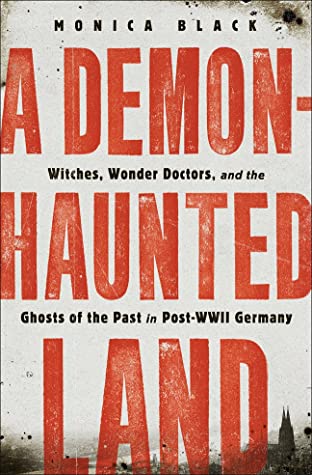
A Demon-Haunted Land
Witches, Wonder Doctors, and the Ghosts of the Past in Post–WWII Germany
- اطلاعات
- نقد و بررسی
- دیدگاه کاربران
نقد و بررسی

August 31, 2020
University of Tennessee history professor Black (Death in Berlin) delivers a fascinating, richly detailed look at the origins of “mass supernatural events” that occurred in West Germany after WWII. Black focuses primarily on the rise of faith healer Bruno Gröning, and on the scores of “witchcraft trials” that took place across the country from 1947 to 1965. Gröning, who believed that “evil people... stopped good people from being well,” lectured to large crowds before authorities cracked down on him for violating a law against treating the sick without a license. He was eventually convicted of negligent homicide in the case of a young girl who stopped her tuberculosis treatments while under his care. Gröning’s “obsession with evil,” Black writes, links him to the country’s simultaneous “witchcraft scare,” in which neighbors took each other to court for spreading rumors of spell casting and evildoing. Black suggests numerous sources for these phenomena, including guilt and shame over the Holocaust, trauma caused by the large numbers of Germans killed or displaced in the final months of the war, and the residual influence of anti-Semitism. Vivid character sketches and keen psychological insights enrich her impressive historical research. The result is an arresting portrait of an unexplored chapter in German history.

September 1, 2020
Of witch trials, quack medicine, and millenarian terrors in the ashes of the Third Reich. Given the fiery end of Hitler's regime and the firebombing of Dresden and other cities, it's understandable that ordinary Germans might have been apocalypse-minded in 1945. That was still true in 1949, writes history professor Black in this sometimes circuitous but well-paced account, four years after the Allied occupation and the division of the country into East and West Germany. In the wave of denazification that immediately followed surrender, old grudges surfaced in accusations of witchcraft and conspiracy theories. At the time, writes the author, German newspapers and kaffeeklatsches alike were also rife with rumors of the end of the world--not so far-fetched given the nuclear proliferation of the Cold War--and with revisitations of the old Norse stories of Ragnarok. Against this backdrop came one of Black's principal subjects, a Danziger who changed his name from a Polish antecedent to the German Gr�ning--and who signed up for the Nazi Party years before the annexation, suggesting that he was looking forward to a comfortable life under Hitler. Instead, he grifted his way across the postwar landscape, engaging in a form of faith healing that yielded a string of faux miracles--but also a negligent homicide or two. (One of Gr�ning's tools, not surprisingly, was tin foil.) The German courts eventually restrained "Gr�ning the Wunderdoktor" from practicing medicine without a license along about the time he died and he and his victims were forgotten. Other memorable figures Black examines include a crusader who "had a way of popping up almost anywhere that witchcraft accusations surfaced" in a country where pharmacies still sold magical potions with names such as "devil's dung" until legally ordered to use "ordinary German names." Though of specialized interest, an eye-opening look into a corner of postwar history that seems more medieval than modern.
COPYRIGHT(2020) Kirkus Reviews, ALL RIGHTS RESERVED.

November 20, 2020
Behind the "economic miracle" of West German prosperity of the 1950s and 1960s lay a populace deeply distrustful of each other, unable and unwilling to confront the monstrous crimes of the Third Reich and the trauma of defeat. Fueled by mounting Cold War tensions, many Germans encountered apocalyptic signs, religious apparitions, faith healers, and witches. The best-known faith healer, an ex-Nazi named Bruno Gr�ning, traveled around West Germany where thousands of people waited hours and sometimes days to hear him speak in hopes of being cured of their ailments. Followers collected balls of aluminum foil containing pieces of Gr�ning's hair and fingernails in hopes of further healing. Around the country, hundreds of people in rural villages and large cities accused their neighbors of witchcraft or attempting to cause harm. Others turned to exorcisms to cast out demonic spirits afflicting friends and neighbors. Author Black (history, Univ. of Tennessee; Death in Berlin) mines rarely used files in local and regional archives to paint this unique portrait of West Germany. VERDICT Readers interested in German and Cold War history and cultural studies of religious and supernatural beliefs will find much to enjoy in this rich study.--Chad E. Statler, Westlake Porter P.L., Westlake, OH
Copyright 2020 Library Journal, LLC Used with permission.




دیدگاه کاربران